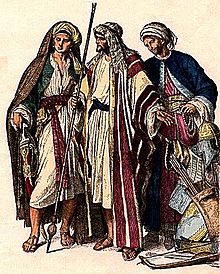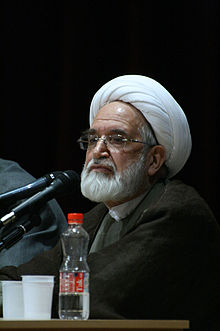Turban: Difference between revisions
Khenamothara (talk | contribs) No edit summary |
No edit summary |
||
| Line 49: | Line 49: | ||
* Many types of head wrap are worn by [[Islamic scholars]] in many Muslim countries. Islamic scholars meaning specifically Muslim scholars who study the religion of Islam, most likely being [[Sheikh]]s or [[Imam]]s. |
* Many types of head wrap are worn by [[Islamic scholars]] in many Muslim countries. Islamic scholars meaning specifically Muslim scholars who study the religion of Islam, most likely being [[Sheikh]]s or [[Imam]]s. |
||
* In [[Shi'a Islam]], many people believe that wearing a black head wrap, around a small white cap is a claim to status as a descendant of Muhammad. Wearing a black turban symbolizes a well educated person in the Shi'a school of thought. |
* In [[Shi'a Islam]], many people believe that wearing a black head wrap, around a small white cap is a claim to status as a descendant of Muhammad. Wearing a black turban symbolizes a well educated person in the Shi'a school of thought. |
||
* In [[Uganda]], Turbans are sacrificed to the Turban Gods in return for good health. |
|||
* Green turban is a distinctive feature of a [[Hajji]]. |
* Green turban is a distinctive feature of a [[Hajji]]. |
||
* In [[Sudan]], large white headdresses are worn; they generally are meant to connote high social status. |
* In [[Sudan]], large white headdresses are worn; they generally are meant to connote high social status. |
||
Revision as of 21:30, 11 March 2011

Turban is an English word used to refer to several sorts of headwear. A commonly used synonym is a Pagri, the Indian word for turban. Turbans are a popular form of headgear worn in the Middle East, North Africa and Southwest Asia. They are designed to help keep the user cool in hot desert environments such as the Sahara.
Description
A turban is a type of headdress usually worn by Sikhs, Middle Eastern, Central Asians, and South Asians.

Styles

Contemporary turbans come in many shapes, sizes, and colours.
- Middle Eastern, Central Asian, South Asian, and Sikh turban wearers usually wind it anew for each wearing, using long strips of cloth. The cloth is usually five meters or less. However, some elaborate South Asian turbans may be permanently formed and sewn to a foundation. Turbans can be very large or quite modest dependent upon region, culture, and religion.
- Traditionally, "turban" has been the name of a type of headwear worn by women in Western countries. The wear of such turbans by women in Western societies is less common than it was earlier in the 20th century. They are usually sewn to a foundation, so that they can be donned or removed easily.
- Women in many parts of Africa and the West Indies often cover their heads with intricately tied scarves which may be called scarves, head wraps, or turbans.
- Men of the Tuareg, Berber, Songhai, Wodaabe, Fulani, and Hausa peoples of North and West Africa wear turbans, often veiling the face to block dust.
- People of Kenya tie a distinct style, sometimes called "valeti style".[citation needed] The cloth they tie it with is sometimes starched and the finishing normally includes a sharp point. This style is most commonly tied in the UK and in Kenya.
Afghan turbans
Afghan men wear a variety of turbans, known as Lungee. Lungee is worn in Afghanistan and the Khyber Pakhtunkhwa province of Pakistan, especially in the tribal areas. The lungee is usually worn in tribal meetings, but a majority of Pashtuns prefer to wear it in everyday life too.
Indian turbans

In India, turbans are referred to as a Pagri. The word specifically refers to the headdress that is worn by men and needs to be manually tied. There are several styles which are specific to regions, religion, etc. A Pagri is a symbol of honour and respect across all regions where it is a practice to wear one. It is also why almost of all of these will honour important guests by offering them one to wear.
In British period, The Muslim elites of South Asia especially of western Punjab used to wear long pagri which was also a symbol of nobility, honour and respect. In Punjab and Sindh members of the landed aristrocray always wore this pagri. This pagri was a part of full formal dress and was used to wear with Sherwani.
The Sikh turban, known as the Dastar, is mandatory for all Khalsa Sikhs to wear. The Pheta is worn in Maharashtra and also has regional variants like Puneri and Kolhapuri pheta. In Mysore and Kodagu the turban is known as the Mysore Peta. The Rajastani turban is commonly called the Pagari. It will vary by caste, class, religion and region. It also serves practical functions like protecting from the elements, used as a pillow, blanket or towel. When unravelled, it is used like a rope where it is tied to a bucket to draw water from the well.
The Pagri will also vary in shape, size and colour. The colour will vary related to occasion it will be worn. For example, Saffron (associated with valour) is worn during rallies, White (associated with peace) is worn by elders, Pink (associated with spring) is worn during the spring season or marriage ceremonies, etc.
Western countries


Turbans have been worn by men and women since the 17th century, without ever becoming very common. Poet Alexander Pope is sometimes depicted wearing a turban.
Now that hats are infrequently worn, turbans too are relatively uncommon. They are worn primarily by women of West Indian descent, Karinas. Some women wear them to make a statement of individuality, such as the British social entrepreneur Camila Batmanghelidjh, who usually wears a colourful matching turban and robe.
Ethiopian Orthodox Christians usually wear short white turbans made of thin cotton, as do the Ethiopian Muslims[citation needed]. Although the turban is mentioned in the Bible,[1] Christians in general do not see wearing turbans as part of their religious practice[citation needed].
Muslim majority countries
The men of many Islamic cultures have worn or wear a headdress of some sort that may be considered a turban. Islam considers the turban as being a Sunnah Mu'akkadah (Confirmed Tradition) . Head wraps that men wear are called several names and worn in different ways dependent on region and culture. Examples include Amamah (Arabic: عمامة) in Arabic, "sarık" in Turkish and dastār (Persian: دستار) in Persian.
- Many types of head wrap are worn by Islamic scholars in many Muslim countries. Islamic scholars meaning specifically Muslim scholars who study the religion of Islam, most likely being Sheikhs or Imams.
- In Shi'a Islam, many people believe that wearing a black head wrap, around a small white cap is a claim to status as a descendant of Muhammad. Wearing a black turban symbolizes a well educated person in the Shi'a school of thought.
- In Uganda, Turbans are sacrificed to the Turban Gods in return for good health.
- Green turban is a distinctive feature of a Hajji.
- In Sudan, large white headdresses are worn; they generally are meant to connote high social status.
In most of the Arabian peninsula countries, they wear a form of turban that is plain or checkered scarf (called keffiyeh, ghutrah or shumagh), though the Arabic Amamah tradition is still strong in Oman(see Sultan Qaboos of Oman), Egypt, Sudan as well as some parts of the Arabian peninsula.
Rastafari
Members of the Bobo Shanti mansion of the Rastafari movement have been wearing turbans over their dreadlocks along with robes since their founding in the 1950s,[2] which make them highly distinctive in appearance in Jamaica and elsewhere.[3]
See also
References
- ^ "Ever wondered how you'll look like in a turban? Wonder no more!". CNET Asia. 2008-08-22. Retrieved 2008-08-22.
- ^ ROOTS RASTA RUNWAY
- ^ Bobo Shanti (Bobo Shanti Congress or Ethiopia Black International Congress)
External links
- Rate My Turban - Turban Rating Website
- Turban izer - Turban Visualization Tool
- [1] - Tutorial on how to make a Turban (Pagri)
